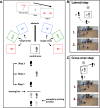Embodied decisions during walking
- PMID: 36197022
- PMCID: PMC9678422
- DOI: 10.1152/jn.00149.2022
Embodied decisions during walking
Abstract
Research on embodied decision-making only recently started to examine whether and how concurrent actions influence value-based decisions. For instance, during walking humans preferably make decisions that align with a turn toward the side of their current swing leg, sometimes resulting in unfavorable choices (e.g., less reward). It is suggested that concurrent movements influence decision-making by coincidental changes in motor costs. If this is true, systematic manipulations of motor costs should bias decisions. To test this, participants had to accumulate rewards (i.e., points) by walking and turning toward left and right targets displaying rewards across three experiments. In experiments 1a and 1b, we manipulated the turning cost based on the current swing leg by applying different symmetric turning magnitudes (i.e., same angles for left and right targets). In experiment 2, we manipulated the turning cost by administering asymmetric turning magnitudes (i.e., different angles for left and right targets). Finally, in experiment 3, we increased the cost of walking by adding ankle weights. Altogether, the experiments support the claim that differences in motor costs influenced participants' decisions: experiments 1a and 1b revealed that the swing leg effect and stepping behavior were moderated by turning magnitude. In experiment 2, participants showed a preference for less costly, smaller turning magnitudes. Experiment 3 replicated the swing leg effect when motor costs were increased by means of ankle weights. In conclusion, these findings provide further evidence that value-based decisions during ongoing actions seem to be influenced by dynamically changing motor costs, thereby supporting the concept of "embodied decision-making."NEW & NOTEWORTHY Motor processes of concurrent movements have been shown to influence embodied decision-making. It is hypothesized that this is driven by coincidental changes in motor costs. We tested this claim by systematically manipulating motor costs of choice options during walking. In three experiments we show how variations in motor cost (e.g., turning angle or stepping constraints) bias decision-making, thereby supporting the concept of "embodied decision-making."
Keywords: decision-making; embodied choices; gait; motor cost; reward.
Conflict of interest statement
No conflicts of interest, financial or otherwise, are declared by the authors.
Figures







References
Publication types
MeSH terms
LinkOut - more resources
Full Text Sources

